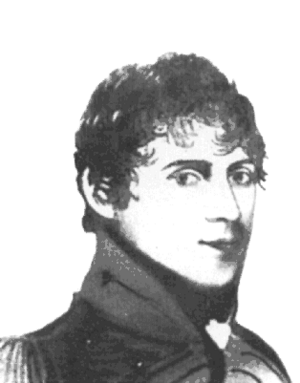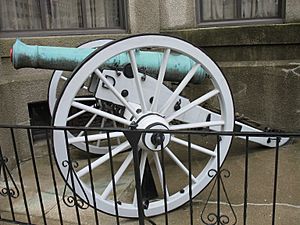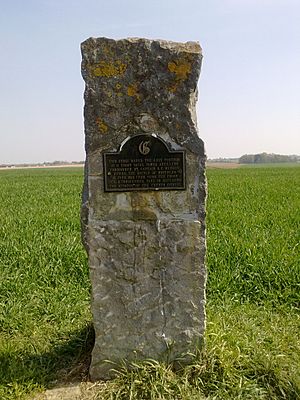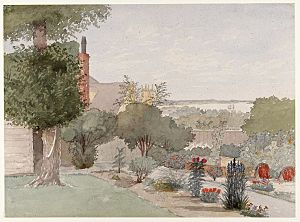Cavalié Mercer facts for kids
Quick facts for kids
Alexander Cavalié Mercer
|
|
|---|---|
 |
|
| Born | 1783 Kingston upon Hull, Yorkshire |
| Died | 1868 Cowley, Devon |
| Allegiance | |
| Service/ |
British Army |
| Years of service | 1798 to c.1854 |
| Rank | General |
| Unit | Royal Horse Artillery |
| Commands held | G Troop Royal Horse Artillery in the Waterloo Campaign, 1815 D Troop Royal Horse Artillery 6th company 5th battalion Royal Artillery Royal Artillery, Nova Scotia Dover Garrison |
| Battles/wars | Buenos Aires expedition of 1807 Waterloo Campaign and Waterloo Aroostook War |
| Awards | Waterloo Medal |
| Other work | Author and artist |
Alexander Cavalié Mercer (born March 28, 1783 – died November 9, 1868) was a British artillery officer. He became a general. But he is best known for leading G Troop of the Royal Horse Artillery during the fierce Battle of Waterloo. He also wrote a famous book called Journal of the Waterloo Campaign.
Mercer's troop had six guns pulled by horses. They arrived too late for the Battle of Quatre Bras. But they helped protect the army's retreat to Waterloo. This troop fought on the far right side of Wellington's army at Waterloo. Later, they moved to the middle of the battle.
There, they faced many attacks from French heavy cavalry. Mercer bravely chose not to follow orders to leave his guns. Instead, he kept fighting even when the enemy was very close. A special memorial marks this spot on the Waterloo battlefield today. After the battle, Mercer's troop marched to Paris with the Allied armies. They stayed there as part of the army that occupied the city.
Mercer's Journal is a very important book for historians. It describes the Waterloo campaign in great detail. It also paints a picture of Belgium and France in the early 1800s. It is one of the few accounts from that time written by an artillery officer.
Mercer stayed in the army during peacetime. He served twice in Canada. He was also a talented painter. The National Gallery of Canada bought many of his watercolour paintings of Canadian landscapes in the 1980s.
Contents
Early Life and Military Career
Mercer was born in 1783 in Kingston-upon-Hull, Yorkshire. He came from a military family. His father, General Alexander Mercer, was in the Royal Engineers. The name Cavaillie might have come from his grandmother.
Mercer went to the Royal Military Academy, Woolwich. He joined the Royal Regiment of Artillery as a lieutenant in 1799. He was only 16 years old. He served in Ireland after the Irish Rebellion of 1798. In 1806, he was promoted to second captain. This was a special rank in the Ordnance department.
Getting promoted in the Royal Artillery was very slow back then. It depended only on how long you had served. Unlike other parts of the British Army, officers could not buy their promotions. Mercer became a major in 1824, but this rank was dated back to 1819.
Around 1806, Mercer joined G Troop of the Royal Horse Artillery. He went on the Buenos Aires expedition in 1807. He did not fight in the Peninsular War. His next war service was in the Waterloo Campaign.
Mercer's G Troop
In 1815, Mercer was the acting commander of G Troop, Royal Horse Artillery. It is often called Mercer's Troop or Mercer's Battery. Today, its successor is G Parachute Battery (Mercer's Troop) Royal Horse Artillery. This unit is part of the 7th Parachute Regiment Royal Horse Artillery. They use the L118 Light Gun and serve with the 16 Air Assault Brigade.
G Troop had been part of the 1807 Buenos Aires expedition. But the G Troop that fought at Waterloo was new. It was formed by combining two other RHA troops. They picked the best horses from each unit. This made it a very strong and impressive troop.
When Blücher saw the cavalry in May 1815, he supposedly said, "there is not one horse in this battery that is not fit for a field marshal." The troop had five 9-pounder guns and a 5½-inch howitzer. They had 80 gunners, 86 drivers, and 226 horses.
The Waterloo Campaign
Mercer's Troop sailed to Belgium on April 11, 1815. This was just after Napoleon escaped from Elba. From May 1 until the French invasion on June 15, they lived quietly in the village of Strijtem.
On June 16, G Troop rode all day. But they arrived too late for the Battle of Quatre Bras. On June 17, they helped cover the retreat from Quatre Bras. They barely escaped being captured by French cavalry. Later that day, they fought in the action at Genappe with the cavalry rearguard.
When they reached the Waterloo battlefield, Mercer's Troop briefly took a position behind a sandpit. This spot would be important the next day. Mercer was still protecting the rear of Wellington's army. He did not know the whole army had stopped right behind him. His troop exchanged fire with French cannons before moving back.
Mercer was about to lead his troop into action on his own. But he was ordered to the far right side of the battle line. This was a quiet area. However, like many of Wellington's artillery units, Mercer did not follow orders to avoid shooting at enemy cannons. He fired at the enemy guns. This drew heavy fire from stronger French artillery in return.
In the afternoon, Mercer's Troop was suddenly ordered to the most intense part of Wellington's line. This was between the crossroads and Hougoumont. A memorial now marks their position. They set up right behind the ridge road, which was on a small raised bank. This bank gave them good cover from enemy artillery. It also made Mercer's case-shot more effective.
The troop was positioned between two squares of Brunswick infantry. Mercer thought these soldiers were not very steady. He was ordered to lead his men into the squares when cavalry approached. But he decided they would be safer staying with their guns. Unlike other batteries in that area, Mercer's gunners never left their guns. They did not hide in the infantry squares.
Large groups of French heavy cavalry attacked many times from about 3:15 p.m. The Horse Grenadiers of the Imperial Guard were already coming through the smoke. They were moving at a trot. Mercer's guns opened fire with case-shot from close range. This caused terrible casualties. The French hesitated. Their front ranks tried to retreat, but the back ranks pushed forward. This made them confused under Mercer's deadly fire. They eventually pulled back.
Before the second charge, French mounted skirmishers fired their carbines at Mercer's Troop from close range. Mercer held his fire to save ammunition. To keep his men calm, Mercer rode back and forth in front of his troop. He taunted the enemy in French. This drew aimed, but inaccurate, carbine fire in return.
The second main attack came in columns. Cuirassiers led the way. Mercer's Troop waited for them. They loaded their guns with two types of shot: case-shot over ball. They fired when the enemy was 50 or 60 yards away. Mercer reported that the entire front line of the enemy fell. The round-shot tore through the column behind them. The ground became almost impossible to cross because of dead and wounded horses and men. So, the enemy could not reach the gun-line. Mercer's Troop and the Brunswick infantry fired quickly. The enemy fell like "grass before the mower's scythe." The biggest danger to Mercer's men was between the charges. This came from French skirmishers and artillery.
The third and final charge had little chance of reaching the guns. Some individual cavalrymen rode between the guns each time. But they only did this to escape to the British rear. As the third attack pulled back, the troop had to stop firing. This allowed the Duke of Wellington to pass along the road. Soon after, Wellington's infantry advanced. They left the guns on the ridge to fire at large groups of French troops in the valley below.
Towards the end of the battle, an enemy battery set up on the ridge to Mercer's left. It fired into the side of his troop. This caused many casualties among the limber-horses. A newly arrived Belgian battery eventually drove this enemy battery away. The hostile battery might have been Prussian. But Mercer did not believe this, even when a Brunswick cavalry officer told him so.
Mercer's troop had lost too many horses. So, they could not move when the general advance was ordered. Mercer slept under a limber, among the dead and wounded.
The troop had 5 men killed and 15 wounded at Waterloo. They also lost 69 horses. They fired 700 rounds of ammunition. Sir Augustus Frazer said, "I could plainly distinguish the position of G Troop from the opposite height by the dark mass of dead French cavalry which, even at that distance, formed a remarkable feature on the field."
After the Battle
Mercer's Troop stayed on the battlefield until 3 p.m. the next day. Mercer spent the day exploring the field. He visited Hougoumont and talked to the wounded. Once their ammunition and supply wagons rejoined them, the troop moved towards Nivelles. They left some guns and carriages behind because they lacked horses. They rejoined the army near Mons on June 21. Then they marched to the gates of Paris without more fighting. They were ordered to cantonments at Colombes in early July 1815. Mercer spent much of the rest of the year enjoying Paris as a tourist. He had two months of leave in England.
Mercer was transferred to command D Troop RHA in July 1815. He returned to England with it in January 1816.
After the campaign, Mercer was put on half-pay from 1816 to 1821. He was called back to the army. He served twice in British North America. First, he commanded the 6th company of the 5th battalion Royal Artillery at Quebec starting in 1823. He returned to England in 1829. He then held commands at Woolwich and Devonport.
He was promoted to lieutenant-colonel in 1835. He served again in British North America from 1837 to 1842. He commanded the artillery in Nova Scotia during a border dispute with the United States. This dispute became known as the Aroostook War. He was promoted to colonel in 1846, to major-general in 1854, and to lieutenant-general in 1857.
He was the commandant of the Dover garrison before he retired from active service. But he was appointed Colonel Commandant of the 9th Brigade Royal Artillery in 1859. So, he was never officially on the retired list. He was promoted to full general in 1865.
During his time in Lower Canada (1828–29) and Nova Scotia (1840–42), Mercer painted many watercolours. The National Gallery of Canada bought these paintings in the 1980s. In 2014, Glenn Devanney wrote a book about Mercer's paintings of Halifax. It includes historical text and 52 paintings.
Mercer married Frances (or Fanny) Rice in 1813. She traveled with him to France in 1815. They had one son, Cavalié A. Mercer. Their son later edited his father's Journal. Mercer and Fanny lived in Berkshire during the Waterloo campaign. Later, Mercer lived at Cowley Hill near Exeter. He died there in 1868 and is buried at St. David's Church, Exeter.
A project is currently working to restore Mercer's grave. This is for the 200th anniversary of Waterloo. They also plan to add signs and create a fund to care for the grave for the next 100 years. On June 18, 2015, a service was held at Mercer's graveside. Members of Mercer's G Troop paid their respects.
His book, Journal of the Waterloo Campaign kept throughout the campaign of 1815, was published in 1870. This was after he died. He wrote it about 30 years earlier. He used his original notes and added details from letters and other sources. The book covers April 1815 to January 1816. It includes a break when he was on leave in England. Mercer admitted he had little time to write his journal during the busy days around Waterloo. So, his account might not be completely accurate.
The Journal is known for its long descriptions of the countryside and its people. It also describes life in Paris during the Allied occupation. Very little of the book is about military matters. Mercer seemed to spend most of his days walking, riding, or sightseeing in Paris.
Images for kids








